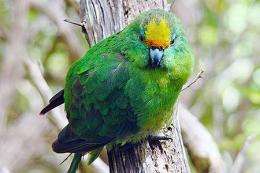Critically endangered parakeets back from the brink on Maud Island

(Phys.org)—The critically endangered orange-fronted parakeets are thriving at Maud Island in the Marlborough Sounds, a new study has found.
A base population of 11 has jumped to nearly 100 since the birds were moved to the predator-free sanctuary five years ago. However, there are still less than 1000 birds worldwide.
The study, by Dr Luis Ortiz-Catedral and Professor Dianne Brunton from Massey University's Institute of Natural Sciences, investigated what happened after 11 captive-bred Malherbe's parakeets (Cyanoramphus malherbi) or kākāriki karaka weremoved to Maud Island in 2007.
A native New Zealand bird, the orange-fronted parakeets are listed as critically endangered on Red List of Threatened Species by the International Union for Conservation of Nature (IUCN). In 2004 it was estimated there were between 300 and 500 Malherbe's parakeets left in the world.
In December 2005, captive-bred birds were moved to Chalky Island in Fiordland, and in 2007 transported to Maud Island began. Further populations were moved to Tuhua Island in December 2009 and Blumine Island in 2011 and this year.
With funding from the Department of Conservation, Forest & Bird and the Mohamed bin Zayed Species Conservation Fund, Dr Ortiz-Catedral surveyed the Maud Island birds. He used a simple methodology based on sightings and estimated their survival during the study period, known as "mark-resighting".
Due to the secretive nature of New Zealand parakeets, this methodology had not been used before. However, on Maud Island the tameness of parakeets allowed for detailed, repeated observations of the birds in their new habitat. Dr Ortiz-Catedral says after success with the parakeets, this method could be applied to similar species in other island populations in New Zealand and around the world.
Since March 2007, regular surveys were conducted on Maud Island to record juveniles hatched on site and others released on the island. Within two years, Dr Ortiz-Catedral estimates the population increased from 11 to a maximum of 97 birds, due to the high reproductive potential of the species, and the absence of introduced mammalian predators.
"The evidence from this study suggests translocating captive-bred birds to sanctuaries like Maud Island, which are free of invasive predators, is an effective management method for increasing the global population size of the species," he says. "It is hoped this will eventually downgrade its IUCN threat category."
Dr Brunton says the study is an excellent starting point for further monitoring programmes for other parakeets managed through translocation, and proves such a managed conservation programme is effective.
Orange-fronted parakeets remain one of the least known forest birds in New Zealand due to their rarity, and the ambiguity of their status as a separate species.
Dr Ortiz-Catedral hopes that this study will promote awareness of the species.
The study was published in Conservation Evidence's 2012 online journal. www.conservationevidence.com/j … rnal.php?id=9#volume
Provided by Massey University

















